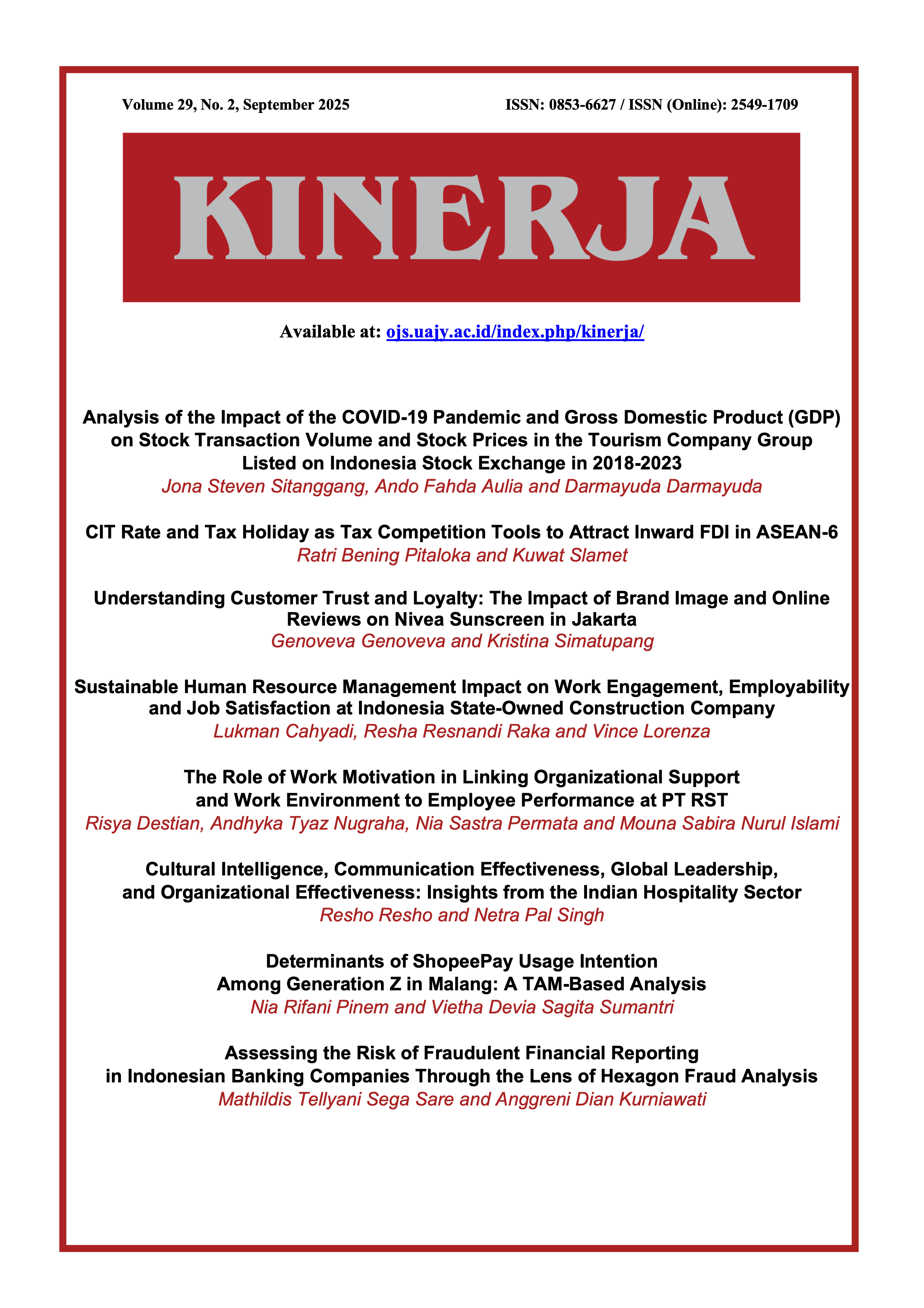Cultural Intelligence, Communication Effectiveness, Global Leadership, and Organizational Effectiveness: Insights from the Indian Hospitality Sector
DOI:
https://doi.org/10.24002/kinerja.v29i2.10233Keywords:
cultural intelligence, hospitality sector, confirmatory factor analysis, global leadership, communication, organizational effectivenessAbstract
The increasing globalization of business operations has heightened the need for leaders capable of navigating culturally diverse environments. This study explores the interrelationships between cultural intelligence (CQ), communication effectiveness, global leadership, and organizational effectiveness within the context of India’s hospitality sector. This research examines how these constructs interact to influence organizational outcomes by using exploratory and confirmatory factor analyses (EFA and CFA) and structural equation modeling (SEM). Data collected from 360 managers working in various sub-sectors of the hospitality industry reveal significant positive relationships between the constructs. The findings emphasize the importance of CQ as a foundational competency for communication effectiveness and global leadership, which collectively enhance organizational performance. This paper contributes to the growing discourse on leadership in multicultural and emerging market contexts, offering practical insights for organizations and policymakers.
References
Arbuckle, J.L. & Wothke, W., 1999. AMOS 4.0 User’s Guide. Chicago, IL: SPSS.
Bartlett, C.A. & Ghoshal, S., 1992. What is a global manager? Harvard Business Review, September–October, pp.124–132.
Bennis, W., 1989. On Becoming a Leader. New York, NY: Addison-Wesley.
Black, J.S. & Gregersen, H., 2000. High impact training: Forging leaders for the global frontier. Human Resource Management, 39(2–3), pp.173–184.
Black, J., Morrison, A. & Gregersen, H., 2008. Global Explorers: The Next Generation of Leaders. New York: Routledge.
Boyacigiller, N., Beechler, S., Taylor, S. & Levy, O., 2006. The crucial yet illusive global mindset. In: H. Lane, M.E. Mendenhall, M. Maznevski & J. McNett, eds. Handbook of Global Management: A Guide to Managing Complexity. Oxford: Blackwell.
Brake, T., 1997. The Global Leader: Critical Factors for Creating the World-class Organization. Chicago, IL: Irwin Professional Publishing.
Burgoon, J.K., 1995. Cross-cultural and Intercultural Applications of Expectancy Violations Theory. In: R.L. Wiseman, ed. Intercultural Communication Theory. Thousand Oaks, CA: Sage, pp.194–214.
Conner, J., 2000. Developing global leaders of tomorrow. Human Resource Management, 39(2–3), pp.147–157.
Cooper, D.R. & Schindler, P.S., 2011. Business Research Methods. New Delhi: Tata McGraw Hill.
Creswell, J.W., 2005. Educational Research: Planning, Conducting, and Evaluating Quantitative and Qualitative Research. 2nd ed. Upper Saddle River, NJ: Pearson Education.
Dowling, P.J. & Schuler, R.S., 1990. International Dimensions of Human Resource Management. Boston: PWS-Kent.
Earley, P.C. & Ang, S., 2003. Cultural Intelligence: Individual Interactions Across Cultures. Stanford, CA: Stanford University Press.
Earley, P.C. & Mosakowski, E., 2004. Cultural Intelligence. Harvard Business Review, 82(10), pp.139–146.
Earley, P.C., Ang, S. & Tan, J., 2006/2012. CQ: Developing Cultural Intelligence at Work. Stanford, CA: Stanford Business Books.
Goleman, D., 2006. Social Intelligence: The New Science of Social Relationships. New York: Bantam Books.
Goleman, D. & Boyatzis, R., 2008. Social intelligence and the biology of leadership. Harvard Business Review, 86(9), pp.74–81.
Gregersen, H.B., Morrison, A.J. & Black, J.S., 1998. Developing leaders for the global frontier. Sloan Management Review, Fall, pp.21–32.
Gregersen, H.B., Morrison, A.J. & Mendenhall, M.E., 2000. The role of training in developing global leaders: A case study at TRW Inc. Human Resource Management, 39(2–3), pp.185–194.
Gudykunst, W.B., 2005. An Anxiety/Uncertainty Management (AUM) Theory of Effective Communication: Making the Mesh of the Net Finer. In: W.B. Gudykunst, ed. Theorizing about Intercultural Communication. Thousand Oaks, CA: Sage.
Gudykunst, W.B. & Kim, Y.Y., 1997. Communicating with Strangers: An Approach to Intercultural Communication. 3rd ed. New York: McGraw-Hill.
Gudykunst, W.B. & Nishida, T., 2001. Anxiety, uncertainty, and perceived effectiveness of communication across relationships and cultures. International Journal of Intercultural Relations, 25, pp.55–71.
Gudykunst, W.B., Nishida, T. & Chua, E., 1986. Uncertainty reduction in Japanese–North American dyads. Communication Research Reports, 3, pp.39–46.
Gudykunst, W.B., Ting-Toomey, S. & Chua, E., 1988. Culture and Interpersonal Communication. Newbury Park, CA: Sage.
Gudykunst, W.B., Yang, S. & Nishida, T., 1985. A cross-cultural test of uncertainty reduction theory: Comparisons of acquaintances, friends, and dating relationships in Japan, Korea, and the United States. Human Communication Research, 11(3), pp.407–455.
Hair, J.F., Tatham, R.L. & Anderson, R., 1998. Multivariate Data Analysis. New Delhi: Prentice-Hall.
Hall, E.T., 1959. The Silent Language. New York: Anchor Press Doubleday.
Harjito, D.A. & Martono, S., 2015. The influence of leadership style and organizational culture on organizational performance through job satisfaction. Kinerja, 19(1), pp.30–39.
Hofstede, G.H., 1980. Culture’s Consequences: International Differences in Work-Related Values. Beverly Hills, CA: Sage.
Hofstede, G., 2001. Culture’s Consequences: Comparing Values, Behaviours, Institutions, and Organizations Across Nations. Thousand Oaks, CA: Sage.
House, R.J., Hanges, P.J., Javidan, M., Dorfman, P. & Gupta, V., eds., 2004. Culture, Leadership, and Organizations: The GLOBE Study of 62 Societies. Thousand Oaks, CA: Sage.
Ireland, D.A. & Hitt, M.A., 2005. Achieving and maintaining strategic competitiveness in the 21st century: The role of strategic leadership. Academy of Management Executive, 19(4), pp.63–77.
Jain, N. & Mukherji, S., 2009. Communicating a holistic perspective to the world: Kautilya on leadership. Leadership and Development Journal, 30(5), pp.435–454.
Kets de Vries, M. & Mead, C., 1992. The Development of the Global Leader Within the Multinational Corporation. In: V. Pucik, N.M. Tichy & C.K. Barnett, eds. Globalizing Management: Creating and Leading the Competitive Organization. New York: John Wiley and Sons.
Lustig, M.W. & Koester, J., 2012. Intercultural Competence: Interpersonal Communication across cultures. 7th ed. Boston: Pearson Education.
Mayer, J.D. & Salovey, P., 1995. Emotional intelligence and the construction and regulation of feelings. Applied and Preventive Psychology, 4, pp.197–208.
McCall, M.W. & Hollenbeck, G.P., 2002. Developing Global Executives: The Lessons of International Experience. Boston: Harvard Business School Press.
Mendenhall, M. & Oddou, G., 1985. The dimensions of expatriate acculturation: A review. Academy of Management Review, 10, pp.39–57.
Moran, R.T. & Riesenberger, J.R., 1994. The Global Challenge: Building the New Worldwide Enterprise. London: McGraw-Hill.
Morrison, A.J., 2000. Developing a global leadership model. Human Resource Management, 39(2–3), pp.117–131.
Ng, K.Y., Van Dyne, L. & Ang, S., 2009. From experience to experiential learning: Cultural intelligence as a learning capability for global leader development. Academy of Management Learning & Education, 8(4), pp.511–526. Available at: https://doi.org/10.5465/amle.8.4.zqr511.
Podsakoff, P.M., MacKenzie, S.B., Lee, J.Y. & Podsakoff, N.P., 2003. Common method biases in behavioral research: A critical review of the literature and recommended remedies. Journal of Applied Psychology, 88(5), pp.879–903. Available at: https://doi.org/10.1037/0021-9010.88.5.879.
Rockstuhl, T., Seiler, S., Ang, S., Van Dyne, L. & Annen, H., 2011. Beyond general intelligence (IQ) and emotional intelligence (EQ): The role of cultural intelligence (CQ) on cross-border leadership effectiveness in a globalized world. Journal of Social Issues, 67(4), pp.825–840. Available at: https://doi.org/10.1111/j.1540-4560.2011.01730.x.
Sari, R.N. & Santosa, A., 2016. The effect of transformational leadership and organizational commitment on employee performance. Kinerja, 20(1), pp.1–14.
Scandura, T.A. & Williams, E.A., 2000. Research methodology in management: Current practices, trends, and implications for future research. Academy of Management Journal, 43(6), pp.1248–1264. Available at: https://doi.org/10.5465/1556348.
Schriesheim, C.A. & Bird, B.J., 1979. Contributions of the Ohio State studies to the field of leadership. Journal of Management, 5(2), pp.135–145. Available at: https://doi.org/10.1177/014920637900500204.
Sekaran, U. & Bougie, R., 2016. Research Methods for Business: A Skill-building Approach. 7th ed. Chichester, UK: Wiley.
Thomas, D.C., 2008. Cross-cultural Management: Essential Concepts. 2nd ed. Thousand Oaks, CA: Sage.
Thomas, D.C. et al., 2008. Cultural intelligence: Domain and assessment. International Journal of Cross Cultural Management, 8(2), pp.123–143. Available at: https://doi.org/10.1177/1470595808091787.
Triandis, H.C., 1994. Culture and Social Behavior. New York: McGraw-Hill.
Trompenaars, F. & Hampden-Turner, C., 1998. Riding the waves of culture: Understanding diversity in global business. 2nd ed. New York: McGraw-Hill.
Wibowo, A. & Wahyudi, S., 2017. The impact of communication effectiveness and cultural intelligence on organizational performance in hospitality industry. Kinerja, 21(2), pp.155–170.
Yukl, G., 2013. Leadership in Organizations. 8th ed. Upper Saddle River, NJ: Pearson Education.
Downloads
Published
Issue
Section
License
Copyright (c) 2025 Resho Resho, Netra Pal Singh

This work is licensed under a Creative Commons Attribution 4.0 International License.















